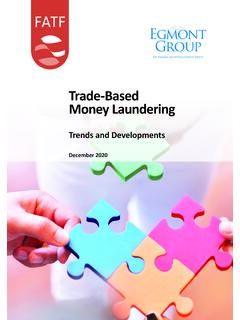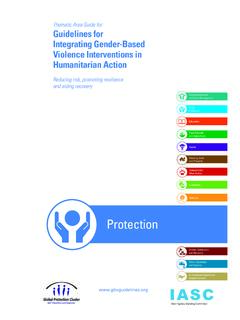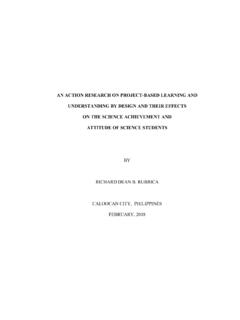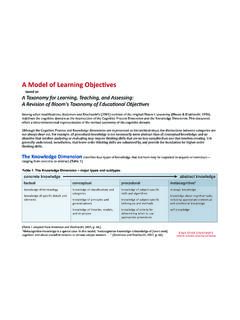Transcription of UPDATED GUIDANCE FOR A RISK-BASED APPROACH
1 OCTOBER 2021 UPDATED GUIDANCE FOR A RISK-BASED APPROACHVIRTUAL ASSETS AND VIRTUAL ASSET SERVICE PROVIDERSThe Financial action Task Force (FATF) is an independent inter-governmental body that develops and promotes policies to protect the global financial system against money laundering, terrorist financing and the financing of proliferation of weapons of mass destruction. The FATF Recommendations are recognised as the global anti-money laundering (AML) and counter-terrorist financing (CFT) standard. For more information about the FATF, please visit This document and/or any map included herein are without prejudice to the status of or sovereignty over any territory, to the delimitation of international frontiers and boundaries and to the name of any territory, city or area. Citing reference: FATF (2021), UPDATED GUIDANCE for a RISK-BASED APPROACH to Virtual Assets and Virtual Asset Service Providers, FATF, Paris, 2021 FATF/OECD.
2 All rights reserved. No reproduction or translation of this publication may be made without prior written permission. Applications for such permission, for all or part of this publication, should be made to the FATF Secretariat, 2 rue Andr Pascal 75775 Paris Cedex 16, France (fax: +33 1 44 30 61 37 or e-mail: Photocredits coverphoto Getty Images Table of contents Acknowledgements .. 2 Acronyms .. 3 Executive Summary .. 4 PART ONE: INTRODUCTION 7 Background .. 7 Purpose of the GUIDANCE .. 9 Scope of the GUIDANCE .. 10 Structure .. 14 PART TWO: SCOPE OF FATF STANDARDS 15 Initial Risk Assessment .. 15 FATF Definitions and Features of the VASP Sector Relevant for AML/CFT .. 21 PART THREE: APPLICATION OF FATF STANDARDS TO COUNTRIES AND COMPETENT AUTHORITIES 37 Application of the Recommendations in the Context of VAs and 37 RISK-BASED APPROACH to Supervision or Monitoring of VASPs .. 70 PART FOUR: APPLICATION OF FATF STANDARDS TO VASPs AND OTHER OBLIGED ENTITIES THAT ENAGE IN OR PROVIDE COVERED VA ACTIVITIES 78 Customer due diligence.)
3 78 Politically exposed persons .. 82 Correspondent banking and other similar relationships .. 82 Wire transfers and the travel rule .. 82 Internal controls and foreign branches and subsidiaries .. 87 STR reporting and tipping-off .. 87 PART FIVE: COUNTRY EXAMPLES OF RISK-BASED APPROACH TO VIRTUAL ASSETS AND VIRTUAL ASSET SERVICE PROVIDERS 89 Summary of Jurisdictional Approaches to Regulating and Supervising VA Activities and VASPs .. 89 PART SIX: PRINCIPLES OF INFORMATION-SHARING AND CO-OPERATION AMONGST VASP SUPERVISORS 102 Objectives .. 102 Principles of Information-Sharing and Co-operation .. 103 Annex A. Recommendation 15 and its Interpretive Note and FATF Definitions .. 107 109 2 UPDATED GUIDANCE : A RISK-BASED APPROACH TO VIRTUAL ASSETS AND VIRTUAL ASSET SERVICE PROVIDERS FATF/OECD 2021 Acknowledgements This UPDATED GUIDANCE document is based on the work of the following Project Team members and the extensive input by the FATF Global Network of FATF Members and FATF-Style Regional Bodies, together making up more than 200 jurisdictions.
4 The GUIDANCE also benefited from consultation with a range of private sector stakeholders and other representatives from the virtual asset and VASP community. The work for this GUIDANCE was led by Habuchi Takahide (Financial Services Agency, Japan) and Jon Fishman and Sandra Garcia (Department of the Treasury, United States of America) with Ken Menz and Tom Neylan from the FATF Secretariat. The Project Team received significant contributions from Evan Gallagher (AUSTRAC, Australia), Amr Sayed Rashed (Egypt Money Laundering and Terrorist Financing Combating Unit), Mirzosharif Sharipov (Eurasian Group Secretariat), Gabriel Hugonnot and Jon Isaksen (European Commission), David Sabban (ACPR, France), Pierre Offret (Minister of the Economy and Finance, France) and Pierre Subiger (Financial Markets Authority, France), Fabian Rieger (Ministry of Finance, Germany), Elad Wieder (Money Laundering and Terror Financing Prohibition Authority, Israel), Francesca Picardi (Ministry of Finance, Italy), Kawada Yuji and Matsuzawa Arisa (Financial Services Agency, Japan), Ricardo Cacho (Secretariat of the Treasury and Public Credit, Mexico), Rachel Huen and Evadne Ong (Monetary Authority of Singapore), Annette Fr sard and Giulia Mariani (FINMA, Switzerland)
5 , Vincent Cottier and Melanie Friedli (Federal Department of Finance, Switzerland), Caroline Horres (Department of the Treasury, United States of America) and Val Szczepanik (Securities and Exchange Commission, United States of America), UPDATED GUIDANCE : A RISK-BASED APPROACH TO VIRTUAL ASSETS AND VIRTUAL ASSET SERVICE PROVIDERS 3 FATF/OECD 2021 Acronyms AEC Anonymity-Enhanced Cryptocurrency AML Anti-Money Laundering CDD Customer Due Diligence CFT Countering the Financing of Terrorism CPF Counter-proliferation financing DApp Decentralised or distributed application DeFi Decentralised finance DNFBP Designated Non-Financial Business and Profession EDD Enhanced due diligence ICO Initial Coin Offering FI Financial institution FIU Financial intelligence unit ML Money Laundering MSB Money Services Business MVTS Money or Value Transfer Service NFT Non-fungible token OTC Over-the-Counter P2P Peer-to-Peer PEP Politically exposed person PF Proliferation financing RBA RISK-BASED APPROACH SRB Self-regulatory body STR Suspicious transaction report TF Terrorist Financing VA Virtual Asset VASP Virtual Asset Service Provider 4 UPDATED GUIDANCE .
6 A RISK-BASED APPROACH TO VIRTUAL ASSETS AND VIRTUAL ASSET SERVICE PROVIDERS FATF/OECD 2021 Executive Summary In October 2018, the Financial action Task Force (FATF) adopted changes to its Recommendations to explicitly clarify that they apply to financial activities involving virtual assets; FATF also added two new definitions to the Glossary: virtual asset (VA) and virtual asset service provider (VASP). The amended FATF Recommendation 15 requires that VASPs be regulated for anti-money laundering and countering the financing of terrorism (AML/CFT) purposes, that they be licensed or registered, and subject to effective systems for monitoring or supervision. In June 2019, the FATF adopted an Interpretive Note to Recommendation 15 to further clarify how the FATF requirements should apply in relation to VAs and VASPs, in particular with regard to the application of the RISK-BASED APPROACH to VA activities or operations and VASPs; supervision or monitoring of VASPs for AML/CFT purposes; licensing or registration; preventive measures, such as customer due diligence, recordkeeping, and suspicious transaction reporting, among others; sanctions and other enforcement measures; and international co-operation.
7 The FATF also adopted a first version of this Guidance1 on the application of the RISK-BASED APPROACH to VAs and VASPs in June 2019; the GUIDANCE was UPDATED in October 2021. It is intended to both help national authorities in understanding and developing regulatory and supervisory responses to VA activities and VASPs, and to help private sector entities seeking to engage in VA activities, in understanding their AML/CFT obligations and how they can effectively comply with these requirements. This GUIDANCE outlines the need for countries and VASPs, and other entities involved in VA activities, to understand the money laundering and terrorist financing (ML/TF) risks associated with VA activities and to take appropriate mitigating measures to address those risks. In particular, the GUIDANCE provides examples of risk indicators that should specifically be considered in a VA context, with an emphasis on factors that would further obfuscate transactions or inhibit VASPs ability to identify customers.
8 The GUIDANCE examines how VA activities and VASPs fall within the scope of the FATF Standards. It discusses the five types of activities covered by the VASP definition and provides examples of VA-related activities that would fall within the definition and also those that would potentially be excluded from the FATF scope. In that respect, it highlights the key elements required to qualify as a VASP, namely acting as a business for or on behalf of another person and providing or actively facilitating VA-related activities. The GUIDANCE describes the application of the FATF Recommendations to countries and competent authorities; as well as to VASPs and other obliged entities that engage in VA activities, including financial institutions such as banks and securities broker-dealers, among others. Almost all of the FATF Recommendations are directly relevant to address the ML/TF risks associated with VAs and VASPs, while other Recommendations are less directly or explicitly linked to VAs or VASPs, though they are still relevant and applicable.
9 VASPs therefore have the same full set of obligations as financial institutions and designated non-financial businesses and professions. 1 This GUIDANCE also updates the 2015 FATF GUIDANCE for a RISK-BASED APPROACH to Virtual Currencies. UPDATED GUIDANCE : A RISK-BASED APPROACH TO VIRTUAL ASSETS AND VIRTUAL ASSET SERVICE PROVIDERS 5 FATF/OECD 2021 The GUIDANCE details the full range of obligations applicable to VASPs as well as to VAs under the FATF Recommendations, following a Recommendation-by-Recommendation APPROACH . This includes clarifying that all of the funds or value- based terms in the FATF Recommendations ( , property, proceeds, funds, funds or other assets, and other corresponding value ) include VAs. Consequently, countries should apply all of the relevant measures under the FATF Recommendations to VAs, VA activities, and VASPs.
10 The GUIDANCE explains the VASP registration or licensing requirements, in particular how to determine in which country/ies VASPs should be registered or licensed at a minimum where they were created; or in the jurisdiction where their business is located in cases where they are a natural person. However, jurisdictions can also choose to require VASPs to be licensed or registered before conducting business in their jurisdiction or from their jurisdiction. The GUIDANCE further underlines that national authorities are required to take action to identify natural or legal persons that carry out VA activities without the requisite license or registration. This would be equally applicable to countries that have chosen to prohibit VAs and VA activities at the national level. Regarding VASP supervision, the GUIDANCE makes clear that only competent authorities, and not self-regulatory bodies, can act as VASP supervisory or monitoring bodies.










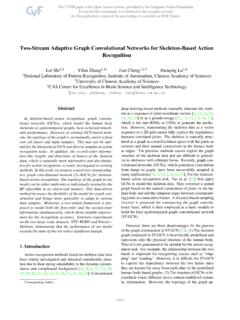
![arXiv:1801.07455v2 [cs.CV] 25 Jan 2018](/cache/preview/c/1/f/1/b/a/a/5/thumb-c1f1baa5f6e090b207f4f18380d23ecd.jpg)

